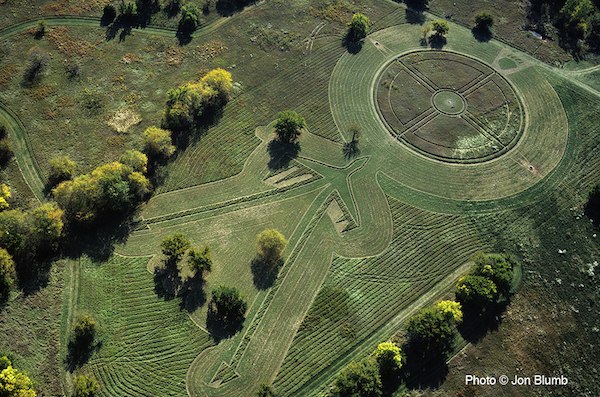New book urges humans to hear the call of place

LAWRENCE — In 1986, a group of people opposed to the construction of a highway through the wetlands south of Lawrence, Kansas, ran a fictional amphibian named Agnes T. Frog against a Douglas County commissioner who supported the roadway.
The frog was defeated, and the highway was eventually built through the wetlands, opening last year. But according to the authors of a new book, the 30-year struggle to preserve the Wakarusa River wetlands was not in vain, and the opponents were onto something by asking the public to consider the nonhuman residents.
“The agency of place” is the key concept in a new book co-authored by University of Kansas Associate Professor of Geography Jay T. Johnson, an affiliate of KU’s Indigenous Studies program. “Being Together in Place: Indigenous Coexistence in a More Than Human World” (University of Minnesota Press, 2017) by Johnson and University of Missouri Associate Professor of Geography Soren C. Larsen argues that indigenous people’s understanding of the interconnected nature of people, places and animals has a special power that ought to be respected, even in what they call “post-colonial settler states.”
In addition to the Wakarusa wetlands controversy, Johnson and Larsen examine two other episodes of struggle over geographic locations pitting indigenous people against governments and corporations dominated by later-arriving ethnic groups: the Waitangi Treaty Grounds in New Zealand and the Cheslatta Carrier Nation’s traditional territory in Canada.
In their introduction, Johnson and Larsen describe the agency of place as a calling: “Because place is a more-than-human engagement, its call is unusual — it is not like a calling to a faith or profession, but rather a summons to encounter, dialogue, and relationship among the humans and nonhumans who share the landscape...
“At the heart of Indigenous activism, then, is the defense of place-based autonomies against settler-state dispossession and oppression.”
Rather than trying to dominate or master the landscape, the floods, fires, extinctions and other ongoing environmental disasters mean people in the United States had better attend to the issues raised in places like Standing Rock, Wakarusa and elsewhere, Johnson said.
“The key lesson is to listen,” Johnson said. “We definitely won’t hear the call of place — the lessons place is trying to teach us — if we don’t slow down and listen.
“The real message at the end is that by failing to listen, to heed call of place, we are creating a world that is increasingly becoming uninhabitable for all of us – plants, animals and humans.”
The call to hear the “voice” of animals is hardly some high-flown notion, Johnson said. He and Larsen use the term “more than human” throughout the book to describe the imperatives of place.
“If you go out and talk to farmers, they will tell you the crops do what they do,” Johnson said. “You have to have a really in-depth relationship to what you are trying to grow, whether it’s cows or soybeans — whatever it might be. We’ve tried desperately to master the environment, but inevitably plants and animals have their own agency.
Anybody who is a rancher, particularly the people I know who raise bison, will tell you animals have their own minds; I can only control them to a certain extent. It’s much more about having a relationship. … As human geographers, are we ignoring the agency of animals or plants or places? Our natural environment is more than human. Calling it human geography is very limiting. In reality, what we are doing is more than human geography.”
Johnson’s chapters on the Wakarusa wetlands sketch their history, including times when first the Haskell Indian Nations University and later Baker University owned a portion of the land. He also traces the evolution of protests against the highway.
“The early part of the protest was almost universally environmental,” Johnson said. “It wasn’t until the late ’80s or early ’90s that the protest took on a more Native American focus. It became more about Haskell and Haskell’s relationship to the wetlands.”
The book’s cover features an image of a medicine wheel constructed in 1992 on Haskell property near the wetlands to draw attention to the sacred nature of the land. Johnson details how Haskell and KU students and teachers cooperated to use the wetlands to teach science and create community.
And though they did not succeed in stopping the roadway, Johnson writes that the struggle had intrinsic benefits to the participants and perhaps beyond them.
“The fight to protect the Wakarusa was not only, perhaps not even primarily, a fight to prevent an environmental injustice; it also was a deeply decolonizing process of place-based learning,” he writes. “The environmental activism at Wakarusa helped many to learn, firsthand, a reciprocal guardianship that does appreciate the active role of the more-than-human. The plants, animals and spiritual guardians of the Wakarusa manifest their agency sometimes in unexpected ways, calling humans into new dialogues and relationships...
“Going forward, the reciprocal guardianship we see at Wakarusa and elsewhere could help Western ecological science move beyond its deep nature-culture dualisms, beyond even the new trend of ecocentrism, and toward the kind of place-based knowing that helps humankind learn its life-supportive roles as one small but important part of Creation’s web.”
Photo: A medicine wheel constructed in 1992 on Haskell Indian Nations University property near the wetlands to draw attention to the sacred nature of the land (Jon Blumb)